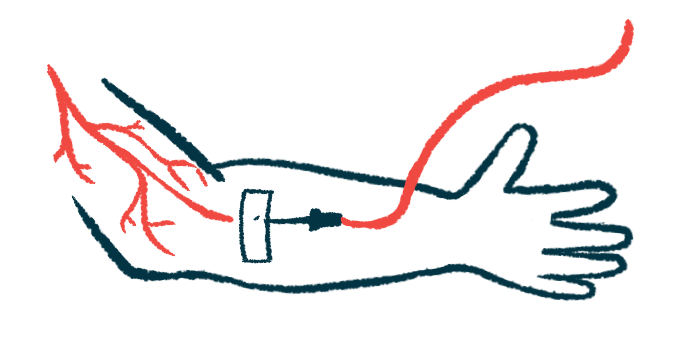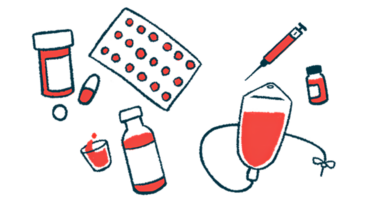Many gMG Patients in US Show ‘Chronic’ Reliance on IVIG Therapy
Heavy use, especially in 1st year, with standard treatment spots 'unmet needs'

Over 40% of adults with generalized myasthenia gravis (gMG) in the U.S. who began off-label treatment with intravenous immunoglobulin (IVIG) became frequent users, with six or more courses in the first year, according to real-world data covering 1,225 patients.
Use of standard treatments, namely corticosteroids and nonsteroidal immunosuppressives, also did not drop over the three-year period following IVIG initiation.
“Our results suggest that a large group of patients with gMG using IVIg have critical remaining unmet needs,” the researchers wrote.
The study, “Real-world utilization patterns of intravenous immunoglobulin in adults with generalized myasthenia gravis in the United States,” was published in the Journal of the Neurological Sciences. This work was led by scientists at Argenx, the biotech company behind Vyvgart (efgartigimod) for gMG.
519 myasthenia gravis patients had 6 or more IVIG treatments in 1 year
MG is an autoimmune disease caused by self-reactive antibodies that target and attack proteins that are part of neuromuscular junctions — the sites of communication between nerve and muscle cells.
Currently, long-term treatment is limited to the use of immunosuppressants, including acetylcholinesterase inhibitors and corticosteroids. But these medications are linked to side effects, and they fail to lessen disease activity in around 20% of patients with hard-to-treat (refractory) MG.
Recently, more effective MG therapies with fewer side effects have become available. IVIG, a combination of immune globulins (immune proteins) that are given directly into the bloodstream, is among them.
IVIG is commonly used as a short-treatment for patients with severe or rapidly worsening MG, and as an add-on to standard care for those with gMG. It may also be a long-term maintenance therapy for patients with refractory disease or those unable to use other treatments.
Despite its wide use, IVIG is not approved by the FDA for MG and real-world studies reporting its effectiveness are lacking.
Researchers analyzed data, stripped of identifying information, from Symphony Health’s Integrated Dataverse, a U.S.-based claims database.
Data, collected from January 2014 through December 2019, covered 1,225 patients who received IVIG as a treatment for gMG. Researchers analyzed the frequency of IVIG treatment and associated costs over a first year of use.
They also compared the use of IVIG along with other gMG treatments in the year prior to IVIG initiation and over the three years after its start.
A broader gMG population — a total of 38,399 patients in the same database and covering the same time period — served as a control group for comparison with IVIG starters.
Among IVIG-treated patients, 519 people (42.4%) received six or more IVIG courses in the first year and were deemed chronic users. The other 706 (57.6%) had one to five IVIG courses and were categorized as intermittent users.
“On average, chronic IVIg users received 12.44 treatment courses while intermittent users received 2.12 courses during the first 12 months post-initiation,” the researchers reported.
A majority (54.1% or 281 people) also continued with frequent use for a second year, and 63.7% of them (179 people) were chronic third year users. In total, 14.6% of all 1,225 patients continued with chronic IVIG use for “at least 3 years,” they noted.
Corticosteroid use continued over three years in patients on IVIG
Prior estimates, also based on U.S. claims data, put mean annual medical costs for each gMG patient at $24,000 to $27,000. Here, mean per patient annual costs were “collectively much higher,” the scientists wrote, particularly for chronic IVIG users compared with intermittent users: a yearly mean of $161,478 vs. $64,888, a nearly 2.5 times increase with frequent IVIG use.
IVIG costs — $10,704 per treatment course with chronic use and $16,580 with intermittent use — accounted for over half (54.2%) of annual medical costs for intermittent users and 82.5% of those costs for chronic users, the study reported.
Patients who started IVIG were significantly younger than controls (mean age of 58.89 vs. 63.51), with fewer IVIG-treated patients being covered by Medicare compared with the broader gMG population (46.6% vs. 55.8%).
IVIG-treated patients had a lower rate of other diseases often linked to gMG, including high blood pressure, excessive fat in the blood (hyperlipidemia), and diabetes, as is “consistent with younger age,” the researchers wrote.
In the year before starting IVIG, a majority of patients (92.16%) used one or more standard of care therapies, and 5.39% used plasma exchange and rituximab as add-on therapies.
Standard of care treatments included cholinesterase inhibitors like Mestinon (pyridostigmine), corticosteroids, and nonsteroidal immunosuppressive treatments (NSISTs). Plasma exchange, rituximab, and Soliris (eculizumab) were considered add-on therapies for more severe or refractory gMG.
Relative to intermittent users, chronic IVIG users relied more often on NSISTs (41.22% vs. 48.55%) and plasma exchange (3.82% vs. 6.55%).
Over the three years after IVIG initiation, patients maintained corticosteroid use and increased that of NSISTs. Researchers also observed a tendency for greater use of add-on therapies, particularly rituximab and Soliris.
“Nearly half of patients with gMG received chronic and multiple IVIg treatment courses within the first year once initiating IVIg treatment, indicating higher usage than expected,” the researchers wrote, without a drop in use of corticosteroids or NSISTs over three years.
“Continuing to better characterize what drives chronic versus intermittent treatment decisions for these unique patient groups is critical, especially as chronic IVIg users are susceptible to significantly greater economic burden,” they added.







